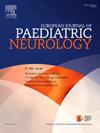Effects of motor imagery adding to physiotherapy and rehabilitation program in children with Duchenne Muscular Dystrophy: does it make a difference?
IF 2.3
3区 医学
Q3 CLINICAL NEUROLOGY
引用次数: 0
Abstract
Introduction/background
The study aims to investigate the effects of the MI (Motor Imagery) program applied in addition to the PTR (Physiotherapy and Rehabilitation) program on gait and balance in children with DMD (Duchenne Muscular Dystrophy).
Methods
The 38 boys with DMD were included in the study and randomized into two groups: the PTR group (mean age: 7.96 ± 1.94 years) and the MI + PTR group (mean age: 9.03 ± 1.71 years). In the PTR group, the PTR program was administered 2 days/week for 8 weeks, and in the MI + PTR group, the MI program was administered 5 days/week in addition to the PTR program. Groups were assessed by the Brooke Lower Extremity Functional Classification Scale, Modified Pediatric Mini Mental Scale, Movement Imagery Questionnaire (MIQ-c), Kinovea® Software Program, Timed Up & Go Test (TUG), Timed Function Tests (TFT), Two-Minute Walk Test (2MWT), and Motor Function Measure (MFM-32).
Results
As a result of the study, in PTR Group, TFT-Stairs descending (p = 0.049) was improved. In MI + PTR Group, Kinovea® Software Program-Walking Speed (p = 0.003), 2MWT (p = 0.037), TFT-Stair descend and 10-m walk (respectively; p = 0.001; p = 0.039), and MFM-32-D1 (p = 0.036) were improved. According to the comparison between groups, the groups were not superior to each other (p > 0.05).
Discussion/conclusion
Although the MI program applied in addition to the PTR program contributes to improvements in walking speed, walking distance, and functional performance in children with DMD, it does not demonstrate superiority over the PTR program alone.
运动意象对杜氏肌营养不良症儿童物理治疗和康复计划的影响:它有区别吗?
本研究旨在探讨MI(运动意象)项目和PTR(物理治疗和康复)项目对DMD(杜氏肌营养不良症)患儿步态和平衡的影响。方法将38例DMD患儿随机分为PTR组(平均年龄7.96±1.94岁)和MI + PTR组(平均年龄9.03±1.71岁)。在PTR组中,PTR计划每周给予2天,持续8周,在MI + PTR组中,MI计划在PTR计划的基础上每周给予5天。各组采用Brooke下肢功能分类量表、改良儿童迷你心理量表、运动意象问卷(MIQ-c)、Kinovea®软件程序、Timed Up &;行走测试(TUG)、计时功能测试(TFT)、两分钟步行测试(2MWT)和运动功能测试(MFM-32)。结果PTR组tft -楼梯下降情况明显改善(p = 0.049)。在MI + PTR组,Kinovea®软件程序-步行速度(p = 0.003), 2MWT (p = 0.037), tft -下楼梯和10米步行(分别;p = 0.001;p = 0.039), MFM-32-D1改善(p = 0.036)。组间比较,各组间无明显优势(p >;0.05)。讨论/结论:虽然在PTR方案之外应用MI方案有助于改善DMD儿童的步行速度、步行距离和功能表现,但它并不比单独使用PTR方案更有优势。
本文章由计算机程序翻译,如有差异,请以英文原文为准。
求助全文
约1分钟内获得全文
求助全文
来源期刊
CiteScore
6.30
自引率
3.20%
发文量
115
审稿时长
81 days
期刊介绍:
The European Journal of Paediatric Neurology is the Official Journal of the European Paediatric Neurology Society, successor to the long-established European Federation of Child Neurology Societies.
Under the guidance of a prestigious International editorial board, this multi-disciplinary journal publishes exciting clinical and experimental research in this rapidly expanding field. High quality papers written by leading experts encompass all the major diseases including epilepsy, movement disorders, neuromuscular disorders, neurodegenerative disorders and intellectual disability.
Other exciting highlights include articles on brain imaging and neonatal neurology, and the publication of regularly updated tables relating to the main groups of disorders.

 求助内容:
求助内容: 应助结果提醒方式:
应助结果提醒方式:


